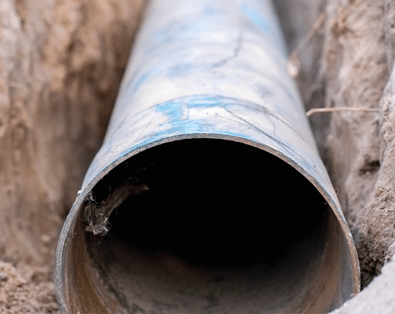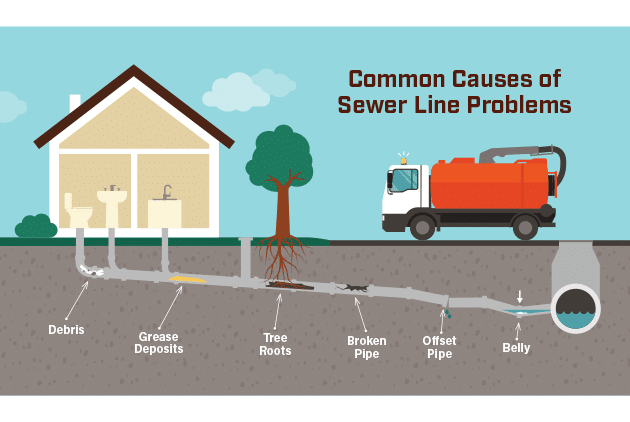What Lies Beneath: Sewer Line Inspections
An overview of sewer line inspections

Clay, cast-iron, the dreaded orangeburg, or more modern materials like ABS (Acrylonitrile Butadiene Styrene) or PVC (Polyvinyl Chloride)? Often, little thought is given to materials that make up the wastewater piping that connects us to the almighty wastewater treatment plant.
Sewer line inspections are becoming more common. Even if nothing comes of the sewer line inspection and the conduit for wastewater is given the “A-OK,” an initial sewer line inspection can provide valuable knowledge and a baseline for a new or potential homeowner.
Here is a walkthrough of a sewer line inspection and several scenarios one might run into in the state of Maine.
What is the goal of a sewer line inspection?
The goal of a sewer line inspection is typically twofold.
The first is to evaluate the condition of the line. It is also helpful to locate the path the line follows to guide homeowners to keep trees from being planted in the vicinity of a line. Though we may not know why, roots love lines flowing with nutrient-rich water.
The second goal is related to responsibility. Often this comes up when there is a problem or repair that needs to be carried out. Digging up a sewer line that’s under asphalt can be expensive. It is not uncommon for a sewer line repair to cost into the thousands of dollars. The client wants to know where their responsibility ends and someone else’s begins. This can be at the entrance to the city’s larger sewer line main or a shared line owned by a housing association, as well as several other eventualities.
What does a sewer line inspection look like?
A sewer inspection begins at the home’s sewer line cleanout. The cleanout is a removable cover that gives access to the sewer line for maintenance or inspection purposes. The cleanout cover is removed; often in Maine it’s a PVC cap that screws off.
Easy enough, or so one thinks. At this point in the inspection, vigilance is paramount. It is important to pay attention to the slope of the pipe corresponding to the cleanout. Things may have settled over time or never have been installed properly to begin with—and that has the potential to provide, shall we say, a rush of effluent toward the inspector.
Anyone present should be notified not to run any water for the same reason. You only forget to remind people once not to run water in the sewer line inspection world.
With the cover open, the inspection camera is then advanced the length of the pipe. There can be a few limitations to this process, though for the most part it is a straightforward procedure; push the camera downstream.
When do you know you’ve arrived and completed the mission? In my opinion it’s more practical to achieve goal number two first; find where the responsibility changes hands.
The entrance to the public city sewer system is not always evident, but fortunately there are a few telltale signs. These can include the increase in pipe diameter from around four to nearly six inches, changes in pipe material, or even the brick-lined sewer hole (a relic from the past).
Another good tip is to watch for the flow of water. If you enter a new segment of pipe and notice water rushing beneath the camera, it’s a good indication you’re in a shared line, unless someone is breaking rule number one.
Once the entrance to the city sewer line has been identified, I inspect the line carefully on the way back. Pulling the camera back can give a smoother feed if recording footage on the way back; I’m also not concerned with advancing the camera at this point, which can take some work and effort, so all my focus is on observing.
“Digging up a sewer line that’s under asphalt can be expensive. It is not uncommon for a sewer line repair to cost into the thousands of dollars. The client wants to know where their responsibility ends and someone else’s begins.”
What are the limitations?
A few things like difficult spaces to work in add variables to the inspector’s mission: Crawl spaces aren’t fun, lack of a cleanout for access, or simply opening the cleanout. In older homes with cast-iron piping the cover is often a brass screw cap. Thanks to galvanic action, the covers may need to be cold chiseled out and replaced with a test fitting after the fact.
The length of the camera reel may not be sufficient; sometimes it can be several hundred feet to a sewer main. The reel I typically use is approximately 130 feet. The first 100 feet on a relatively straight run is easy, but the advancement of the remaining 30 becomes rather difficult after that.
If feasible, running water can help “float” the camera and assist in gaining some extra distance; usually it can get me to the end of the reel. Unfortunately, if the entrance to the city sewer system is farther along than this with no additional cleanouts downstream for access, the inspection is limited to the segments of pipe observed.
Friction plays a large role during the inspection. After a remarkably small number of elbows and turns, advancing the camera gets exponentially more difficult. Standing effluent and accumulated debris both have the capacity to restrict the camera head and obscure observations.
What are the most common defects?
All in all, the process of a sewer line inspection can be straightforward. So, what exactly is the inspector on the lookout for?
Common defects are bellies, separation, damage, bows, accumulated debris, and, of course, root intrusion. Bellies allow for standing sewage within the line—potentially increasing the risk for blockage and/or freezing within the line. Additionally, they may increase the risk of potential bowing or breaking within the line.

Separation may allow debris to infiltrate into the line, causing issues or resulting in effluent springing up somewhere unexpected on the property. Damage can be breaks or compressed sections of line (bows). Anything that might inhibit the free flow of effluent can lead toward possible backups or blockages. Accumulated debris could be paper towels or foreign objects, forks, toy cars—you name it and I’m sure an inspector has seen it. And let us not forget the fan favorite—flushable wipes.
Finally, roots love pipes. It is unclear why roots move toward a pipe. It might be the moisture, it might be the vibration, but they do. The issue with roots is their potential to lead to blockages or backups. When roots intrude they expand, and a root ball can form soon after leading to a sizable blockage. All these conditions can have varying degrees of severity.
With the inspection completed and the cleanout cover securely reinstalled, you achieve several benefits. Video footage of the sewer line has been recorded. This can serve as a baseline for future inspections to gauge changes observed in the line over time, or it can be vital information when brought to a drain line servicing company for recommendations on corrective action. Knowledge has been passed on to the client as to how and where wastewater flows once it’s put down the drain, and hopefully best practices will then be followed. Regardless, thanks to the sewer line inspection, the potential homeowner is now aware.
To Read the Full Article
ASHI offers its members unparalleled resources to advance their careers. ASHI offers training for inspectors at all levels of knowledge and experience, including resources about all major home systems. Members benefit from a vast network of experienced professionals, providing a community for mentorship and knowledge sharing..
In this Issue
Warranty vs Insurance
Letter from the President: Silver Linings
Marketing Minute: 4 Ways to Reach New Customers
A Lesson Learned
Postcards from the Field

FIND A HOME
INSPECTOR
Professional Networking
Grow your professional network, find a mentor, network with the best, and best part of the community that’s making home inspection better every day.
